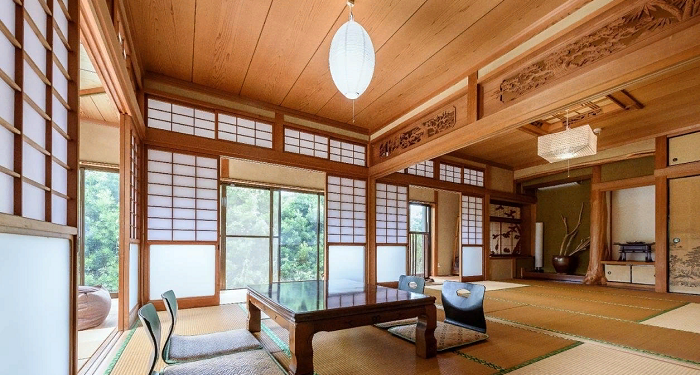In traditional designs, the supporting wall was built of wood and earth, the rest was a wooden frame with removable or sliding screen panels.
The wooden frame of the screen was covered with rice paper. If the house was destroyed, restoration was quick and inexpensive.
Several styles of traditional Japanese housing are known; All of them have the following features:
Materials. In addition to wood, bamboo, straw, and clay were used. The stone, if used, was only for the foundation, more often in temples and wealthy houses.
Roof. It was built with support on wooden beams, was pointed or straight; it was covered with straw or tiles.
Walls. The outer walls were built of wood and earth. The internal space was divided with the help of movable screens – in fact, a free layout.
Floor. It could be earthen or wooden (in the latter case, it was raised on piles by 0.5-0.7 m). The floor was covered with mats (tatami) woven from bamboo or rice straw.
Windows and doors. Apart from the main entrance, windows and doors could change their location, because their role was played by movable screens.
Framed screen panels, sliding or removable, made it possible to flexibly adjust the illumination of the interior space and at the same time blur the boundaries between man-made construction and nature. The filling of the house, furniture and decor, in comparison with European housing, was modest, if not scarce.
Furniture was made of wood and was scarce. Japanese houses inside were filled with the following items:
Kotatsu. An economical heating device in the form of a low table covered with a blanket, under which a heat source was placed. Once a charcoal brazier, it is now being replaced by a safe electric heater.
Cabinets. Always made inline.
Tansu. Mobile (on wheels) medieval chest of drawers or chest. Especially valuable things and books were kept in it; in case of danger (for example, fire), the tansu was rolled out into the street.
Decor. Has been used to a limited extent. In aristocratic houses there was a tokonama – an alcove or a niche in the wall. Inside there was a scroll with a painting or a calligraphic inscription, a flower arrangement (ikebana). Ceramics, incense burners, candlesticks were used as decoration.














